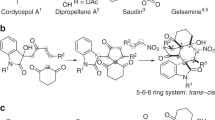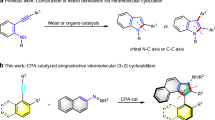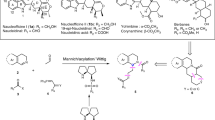Abstract
Single-step constructions of molecules with multiple quaternary carbon stereocentres are rare. The spirooxindole structural motif is common to a range of bioactive compounds; however, asymmetric synthesis of this motif is complicated due to the presence of multiple chiral centres. The development of organocatalytic cascade reactions has proven to be valuable for the construction of several chiral centres in one step. Here, we describe a newly designed organocatalytic asymmetric domino Michael–aldol reaction between 3-substituted oxindoles and methyleneindolinones that affords complex bispirooxindoles. This reaction was catalysed by a novel multifunctional organocatalyst that contains tertiary and primary amines and thiourea moieties to activate substrates simultaneously, providing extraordinary levels of stereocontrol over four stereocentres, three of which are quaternary carbon stereocentres. This new methodology provides facile access to a range of multisubstituted bispirocyclooxindole derivatives, and should be useful in medicinal chemistry and diversity-oriented syntheses of this intriguing class of compounds.
This is a preview of subscription content, access via your institution
Access options
Subscribe to this journal
Receive 12 print issues and online access
$259.00 per year
only $21.58 per issue
Buy this article
- Purchase on Springer Link
- Instant access to full article PDF
Prices may be subject to local taxes which are calculated during checkout




Similar content being viewed by others
References
Nicolaou, K. C., Vourloumis, D., Winssinger, N. & Baran, P. S. The art and science of total synthesis at the dawn of the twenty-first century. Angew. Chem. Int. Ed. 39, 44–122 (2000).
Nicolaou, K. C. & Snyder, S. A. The essence of total synthesis. Proc. Natl Acad. Sci. USA 101, 11929–11936 (2004).
Nicolaou, K. C., Edmonds, D. J. & Bulger, P. G. Cascade reactions in total synthesis. Angew. Chem. Int. Ed. 45, 7134–7186 (2006).
Li, J. W. H. & Vederas, J. C. Drug discovery and natural products: end of an era or an endless frontier? Science 325, 161–165 (2009).
Gaich, T. & Baran, P. S. Aiming for the ideal synthesis, J. Org. Chem. 75, 4657–4673 (2010).
Mugishima, T. et al. Absolute stereochemistry of citrinadins A and B from marine-derived fungus. J. Org. Chem. 70, 9430–9435 (2005).
Bond, R. F., Boeyens, J. C. A., Holzapfel, C. W. & Steyn, P. S. Cyclopiamines A and B, novel oxindole metabolites of penicillium cyclopium westling. J. Chem. Soc. Perkin Trans. 1 1751–1761 (1979).
Galliford, C. V. & Scheidt, K. A. Pyrrolidinyl-spirooxindole natural products as inspirations for the development of potential therapeutic agents. Angew. Chem. Int. Ed. 46, 8748–8758 (2007).
Rottmann, M. et al. Spiroindolones, a potent compound class for the treatment of malaria. Science 329, 1175–1180 (2010).
Lo, M. M. C., Neumann, C. S., Nagayama, S., Perlstein, E. O. & Schreiber, S. L. A library of spirooxindoles based on a stereoselective three-component coupling reaction. J. Am. Chem. Soc. 126, 16077–16086 (2004).
Ding, K., et al. Structure-based design of potent non-peptide MDM2 inhibitors. J. Am. Chem. Soc. 127, 10130–10131 (2005).
Fuji, K. Asymmetric creation of quaternary carbon centers. Chem. Rev. 93, 2037–2066 (1993).
Corey, E. J. & Guzman-Perez, A. The catalytic enantioselective construction of molecules with quaternary carbon stereocenters. Angew. Chem. Int. Ed. 37, 388–401 (1998).
Corey, E. J. Catalytic enantioselective Diels–Alder reactions: methods, mechanistic fundamentals, pathways, and applications. Angew. Chem. Int. Ed. 41, 1650–1667 (2002).
Chen, X., Wei, Q., Luo, S., Xiao, H. & Gong, L. Organocatalytic synthesis of spiro [pyrrolidin-3,3′-oxindoles] with high enantiopurity and structural diversity. J. Am. Chem. Soc. 131, 13819–13825 (2009).
Bencivenni, G. et al. Targeting structural and stereochemical complexity by organocascade catalysis: construction of spirocyclic oxindoles having multiple stereocenters Angew. Chem. Int. Ed. 48, 7200–7203 (2009).
Trost, B. M., Cramer, N. & Silverman, S. M. Enantioselective construction of spirocyclic oxindolic cyclopentanes by palladium-catalyzed trimethylenemethane-[3+2]-cycloaddition. J. Am. Chem. Soc. 129, 12396–12397 (2007).
Antonchick, A. P. et al. Highly enantioselective synthesis and cellular evaluation of spirooxindoles inspired by natural products. Nature Chem. 2, 735–740 (2010).
Dounay, A. B. & Overman, L. E. The asymmetric intramolecular Heck reaction in natural product total synthesis. Chem. Rev. 103, 2945–2963 (2003).
Doyle, A. G. & Jacobsen, E. N. Small-molecule H-bond donors in asymmetric catalysis. Chem. Rev. 107, 5713–5743 (2007).
Barbas, C. F. III . Organocatalysis lost: modern chemistry, ancient chemistry, and an unseen biosynthetic apparatus. Angew. Chem. Int. Ed. 47, 42–47 (2008).
MacMillan, D. W. C. The advent and development of organocatalysis. Nature 455, 304–308 (2008).
Melchiorre, P., Marigo, M., Carlone, A. & Bartoli, G. Asymmetric aminocatalysis—gold rush in organic chemistry. Angew. Chem. Int. Ed. 47, 6138–6171 (2008).
Ramachary, D. B., Chowdari, N. S. & Barbas, C. F. III . Organocatalytic asymmetric domino Knoevenagel/Diels–Alder reactions: a bioorganic approach to the diastereospecific and enantioselective construction of highly substituted spiro[5,5]undecane-1,5,9-triones. Angew. Chem. Int. Ed. 42, 4233–4237 (2003).
Enders, D., Huttl, M. R. M., Grondal, C. & Raabe, G. Control of four stereocentres in a triple cascade organocatalytic reaction. Nature 441, 861–863 (2006).
Enders, D., Grondal, C. & Huttl, M. R. M. Asymmetric organocatalytic domino reactions. Angew. Chem. Int. Ed. 46, 1570–1581 (2007).
Ramachary, D. B., Shiva Prasad, M. & Madhavachary, R. A general approach to high-yielding asymmetric synthesis of chiral 3-alkyl-4-nitromethylchromans via cascade Barbas–Michael and acetalization reactions. Org. Biomol. Chem. 9, 2715–2721 (2011).
Grondal, C., Jeanty, M. & Enders, D. Organocatalytic cascade reactions as a new tool in total synthesis. Nature Chem. 2, 167–178 (2010).
Tian, S. et al. Asymmetric organic catalysis with modified cinchona alkaloids. Acc. Chem. Res. 37, 621–631 (2004).
Li, H., Wang, Y., Tang, L. & Deng, L. Highly enantioselective conjugate addition of malonate and β-ketoester to nitroalkenes: asymmetric C–C bond formation with new bifunctional organic catalysts based on cinchona alkaloids. J. Am. Chem. Soc. 126, 9906–9907 (2004).
Ye, J., Dixon, D. J. & Hynes, P. S. Enantioselective organocatalytic Michael addition of malonate esters to nitro olefins using bifunctional cinchonine derivatives. Chem. Commun. 4481–4483 (2005).
Vakulya, B., Varga, S., Csampai, A. & Soos, T. Highly enantioselective conjugate addition of nitromethane to chalcones using bifunctional cinchona organocatalysts. Org. Lett. 7, 1967–1970 (2005).
McCooey, S. H. & Connon, S. J. Urea- and thiourea-substituted cinchona alkaloid derivatives as highly efficient bifunctional organocatalysts for the asymmetric addition of malonate to nitroalkenes: inversion of configuration at C9 dramatically improves catalyst performance. Angew. Chem. Int. Ed. 44, 6367–6370 (2005).
Singh, R. P. et al. Enantioselective Diels–Alder reaction of simple α,β-unsaturated ketones with a cinchona alkaloid catalyst. J. Am. Chem. Soc. 130, 2422–2423 (2008).
Tan, B., Chua, P. J., Li, Y. & Zhong, G. Organocatalytic asymmetric tandem Michael–Henry reactions: a highly stereoselective synthesis of multifunctionalized cyclohexanes with two quaternary stereocenters. Org. Lett. 10, 2437–2440 (2008).
Tan, B., Lu, Y., Zeng, X., Chua, P. J. & Zhong, G. Facile domino access to chiral bicyclo[3.2.1]octanes and discovery of a new catalytic activation mode. Org. Lett. 12, 2682–2685 (2010).
Singh, R. P., Foxman, B. M. & Deng, L. Asymmetric vinylogous aldol reaction of silyloxy furans with a chiral organic salt. J. Am. Chem. Soc. 132, 9558–9560 (2010).
Peschiulli, A., Procuranti, B., O'Connor, C. J. & Connon, S. J. Synergistic organocatalysis in the kinetic resolution of secondary thiols with concomitant desymmetrization of an anhydride. Nature Chem. 2, 380–384 (2010).
He, R. Ding, C. & Maruoka, K. Phosphonium salts as chiral phase-transfer catalysts: asymmetric Michael and Mannich reactions of 3-aryloxindoles. Angew. Chem. Int. Ed. 47, 4559–4561 (2009).
Bui, T., Syed, S. & Barbas, C. F. III . Thiourea-catalyzed highly enantio- and diastereoselective additions of oxindoles to nitroolefins: application to the formal synthesis of (+)-physostigmine. J. Am. Chem. Soc. 131, 8758–8759 (2009).
He, R., Shirakawa, S. & Maruoka, K. Enantioselective base-free phase-transfer reaction in water-rich solvent. J. Am. Chem. Soc. 131, 16620–16621(2009).
Bui, T., Candeias, N. R. & Barbas, C. F. III . Dimeric quinidine-catalyzed enantioselective aminooxygenation of oxindoles: an organocatalytic approach to 3-hydroxyoxindole derivatives. J. Am. Chem. Soc. 132, 5574–5575 (2010).
Jiang, K., Jia, Z., Yin, X., Wu, L. & Chen. Y. Asymmetric quadruple aminocatalytic domino reactions to fused carbocycles incorporating a spirooxindole motif. Org. Lett. 12, 2766–2769 (2010).
Zhu, Q. & Lu, Y. Stereocontrolled creation of all-carbon quaternary stereocenters by organocatalytic conjugate addition of oxindoles to vinyl sulfone. Angew. Chem. Int. Ed. 49, 7753–7756 (2010).
Wang, L. et al. Highly organocatalytic asymmetric Michael–ketonealdol–dehydration domino reaction: straightforward approach to construct six-membered spirocyclicoxindoles. Chem. Commun. 46, 8064–8066 (2010).
Zhou, F., Liu, Y. & Zhou, J. Catalytic asymmetric synthesis of oxindoles bearing a tetrasubstituted stereocenter at the C-3 position. Adv. Synth. Catal. 352, 1381–1407 (2010).
Galzerano, P. et al. Asymmetric iminium ion catalysis with a novel bifunctional primary amine thiourea: controlling adjacent quaternary and tertiary stereocenters. Chem. Eur. J. 15, 7846–7849 (2009).
Okino, T., Hoashi, Y., Furukawa, T., Xu, X. & Takemoto, Y. Enantio- and diastereoselective Michael reaction of 1,3-dicarbonyl compounds to nitroolefins catalyzed by a bifunctional thiourea. J. Am. Chem. Soc. 127, 119–125 (2005).
Li, H. et al. Stereocontrolled creation of adjacent quaternary and tertiary stereocenters by a catalytic conjugate addition. Angew. Chem. Int. Ed. 44, 105–108 (2005).
Hamza, A., Schubert, G., Soos, T. & Papai, I. Theoretical studies on the bifunctionality of chiral thiourea-based organocatalysts: competing routes to C–C bond formation. J. Am. Chem. Soc. 128, 13151–13160 (2006).
Acknowledgements
The authors acknowledge the Skaggs Institute for Chemical Biology for funding. N.R.C. thanks Fundação para a Ciência e Tecnologia (SFRH/BPD/46589/2008) for financial support. The authors also thank A.L. Rheingold for X-ray crystallographic analysis.
Author information
Authors and Affiliations
Contributions
B.T. and N.C. designed and carried out the chemical experiments. C.B. designed the experiments and supervised the project. All authors discussed the results, contributed to writing the manuscript, and commented on the manuscript.
Corresponding author
Ethics declarations
Competing interests
The authors declare no competing financial interests.
Supplementary information
Supplementary information
Supplementary information (PDF 8082 kb)
Supplementary information
Crystallographic data for compound 3e (CIF 22 kb)
Supplementary information
Crystallographic data for compound 3p (CIF 29 kb)
Rights and permissions
About this article
Cite this article
Tan, B., Candeias, N. & Barbas, C. Construction of bispirooxindoles containing three quaternary stereocentres in a cascade using a single multifunctional organocatalyst. Nature Chem 3, 473–477 (2011). https://doi.org/10.1038/nchem.1039
Received:
Accepted:
Published:
Issue Date:
DOI: https://doi.org/10.1038/nchem.1039
This article is cited by
-
1,3-Dipolar cycloaddition reactions of isatin-derived azomethine ylides for the synthesis of spirooxindole and indole-derived scaffolds: recent developments
Molecular Diversity (2023)
-
Enyne diketones as substrate in asymmetric Nazarov cyclization for construction of chiral allene cyclopentenones
Nature Communications (2022)
-
Highly efficient endo’- selective synthesis of (dispiro 3,2′-pyrrolidinyl) bisoxindoles containing three contiguous chiral stereocenters with two contiguous quaternary spirostereocenters
Journal of Chemical Sciences (2020)
-
Dynamic stereoselective annulation via aldol-oxa-cyclization cascade reaction to afford spirooxindole pyran polycycles
Communications Chemistry (2019)
-
Radical asymmetric intramolecular α-cyclopropanation of aldehydes towards bicyclo[3.1.0]hexanes containing vicinal all-carbon quaternary stereocenters
Nature Communications (2018)



